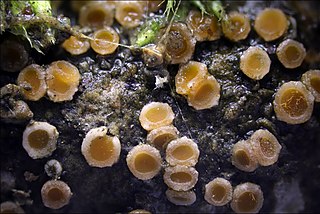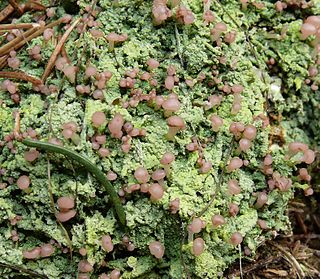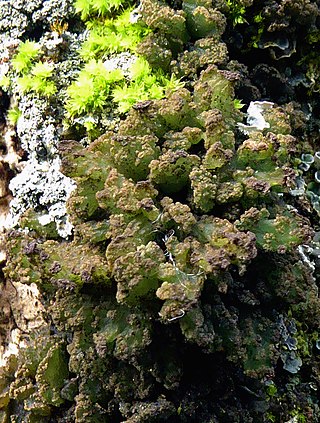
Gyalectales is an order of lichen-forming fungi in the class Lecanoromycetes. It contains 5 families, 18 genera and about 550 species.

The Arthoniales is the second largest order of mainly crustose lichens, but fruticose lichens are present as well. The order contains around 1500 species, while the largest order with lichenized fungi, the Lecanorales, contains more than 14000 species.

The Arthoniaceae are a family of lichenized, lichenicolous and saprobic fungi in the order Arthoniales. The Arthoniaceae is the largest family of Arthoniales, with around 800 species. Most species in Arthoniaceae belong in Arthonia which is the largest genus with 500 species. The second and third largest genus is Arthothelium with 80 species, and Cryptothecia with 60 species.

The Roccellaceae are a family of fungi in the order Arthoniales, circumscribed by French botanist François Fulgis Chevallier in 1826. This family is distinguished by a wide variety of growth forms, including crustose and fruticose thalli, and a diverse range of reproductive structures. Roccellaceae species typically have apotheciate or lirellate ascomata, often with distinct carbonised (blackened) margins. The family has been extensively studied through molecular phylogenetics, revealing significant genetic diversity and complex evolutionary histories.

The Acarosporaceae are a family of fungi in the order Acarosporales. Members of this family have a widespread distribution, and are mostly lichenized with green algae. According to a 2021 estimate, the family contains 11 genera and about 260 species. The family is characterised by a hamathecium formed of paraphysoids.

The Ostropales are an order of fungi in the class Lecanoromycetes. The order was circumscribed by Swedish botanist John Axel Nannfeldt in 1932. The order contains 4 families and 46 genera, including 6 genera of uncertain familial placement.

The Baeomycetales are an order of mostly lichen-forming fungi in the subclass Ostropomycetidae, in the class Lecanoromycetes. It contains 8 families, 33 genera and about 170 species. As a result of molecular phylogenetics research published in the late 2010s, several orders were folded into the Baeomycetales, resulting in a substantial increase in the number of taxa.

The Graphidaceae are a family of lichen-forming fungi in the order Graphidales. The family contains nearly a hundred genera and more than 2000 species. Although the family has a cosmopolitan distribution, most Graphidaceae species occur in tropical regions, and typically grow on bark.

The Gyalectaceae are a family of fungi in the order Gyalectales.

The Stictidaceae are a family of fungi in the order Ostropales. It has 30 genera and about 240 species.

The Bionectriaceae are a family of fungi in the order Hypocreales. A 2008 estimate places 35 genera and 281 species in the family. Species in the family tend to grow on plant material, including woody debris, while some species associate with algae, bryophytes, or other fungi.

The Arctomiaceae are a family of lichenized fungi in the Ascomycota, class Baeomycetales. The family was named by Theodor Magnus Fries in 1861, with Arctomia as the type genus. Species in this family are found in arctic and subarctic habitats, usually associated with bryophytes.

Trichotheliaceae is a family of lichen-forming fungi in the order Gyalectales. The family was circumscribed by Friedrich von Schilling and Friedrich August Georg Bitter in 1927.

Trapeliaceae is a family of lichens in the order Baeomycetales. The family contains 12 genera and about 125 species.
Taitaia is a single-species fungal genus in the family Gomphillaceae. It was circumscribed in 2018 to contain the species Taitaia aurea, a lichenicolous (lichen-dwelling) fungus. This species is characterized by aggregated ascomata with yellow margins, and salmon-red discs that originate from a single base. It is known only from a few sites in Kenya's tropical lower-mountain forests, where it grows on thalli of the lichen Crocodia.

The Rhizocarpales are an order of lichen-forming fungi in the subclass Lecanoromycetidae of the class Lecanoromycetes. It has two families, Rhizocarpaceae and Sporastatiaceae, which contain mostly crustose lichens.
Sphaeropezia is a genus of fungi in the family Odontotremataceae. It has 22 species. Originally circumscribed by Pier Andrea Saccardo in 1884, the genus was resurrected and revised in 2013.

Thelenellaceae is a family of lichen-forming fungi. It is the sole family in the monotypic order Thelenellales, and contains three genera and about 50 species.
Celotheliaceae is a family of fungi in the monotypic order Phaeomoniellales. It contains 27 species of crustose lichens with thalli that are more or less immersed in tree bark.
Ostropomyces is a genus of fungi in the family Stictidaceae. It has two species, both of which are found in tropical forests in northern Thailand, where they grow as saprotrophs on bark.















